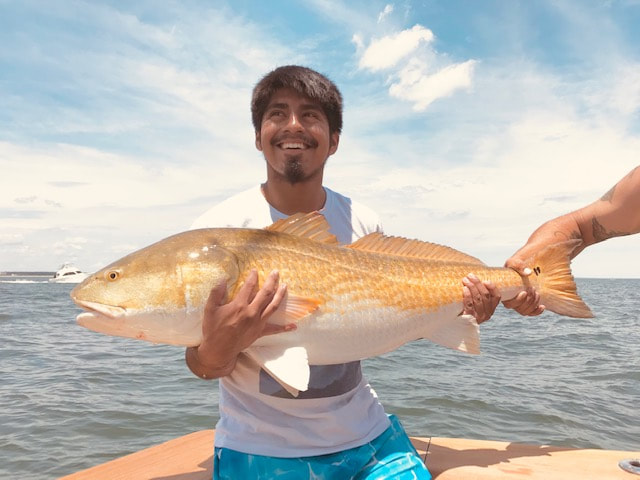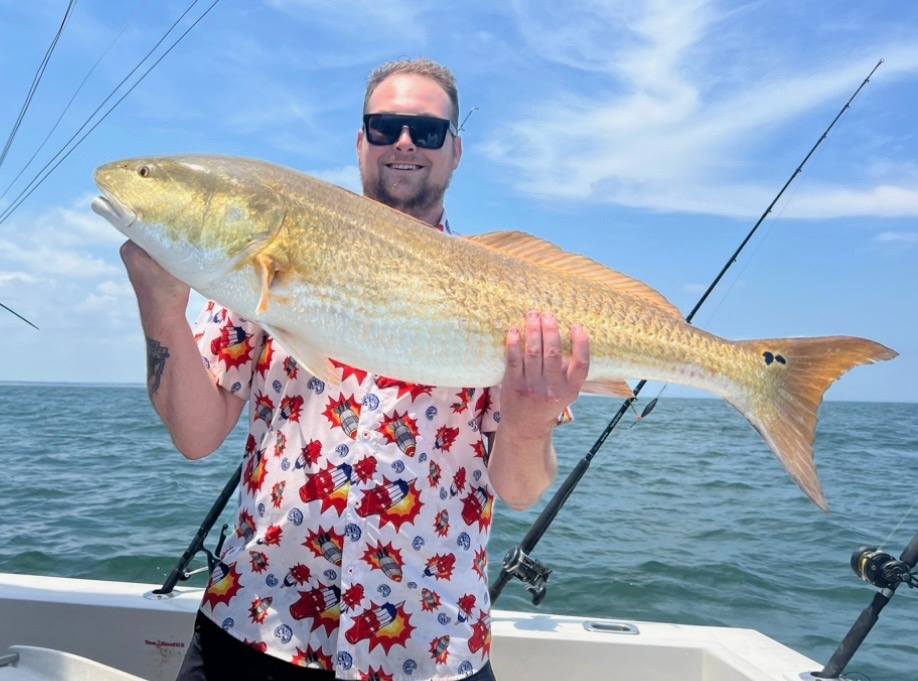Inshore Fishing in Virginia Beach
Virginia Beach Inshore Fishing
Virginia Inshore Trips
Inshore, Nearshore Fishing in Virginia Beach
Virginia Beach Inshore/Nearshore
Deep Sea Fishing in Virginia Beach
Virginia Beach Offshore Trolling
Nearshore Fishing in Virginia Beach
VA Beach Nearshore Action
Inshore Fishing in Virginia Beach
Chesapeake Bay Fishing Trip
Deep Sea, Nearshore Fishing in Virginia Beach
Virginia Beach Offshore Wreck Trip
Inshore, Nearshore Fishing in Hampton
Chesapeake Bay Half & 3/4 Day Trips
Inshore, River, Flats in Virginia Beach
Virginia Beach Back Bay Trips
Inshore Fishing in Virginia Beach
Virginia Beach Luxury Inshore
We started Captain Experiences to make it easy to book fishing and hunting guides around the world. With over 2,000 Damn Good Guides, our platform makes finding and booking a trip seamless. Head here to check out our trips.
Fishing is a popular pastime in Virginia Beach, and while it may seem like a carefree activity, it is important to be aware of the rules and regulations surrounding fishing to ensure the protection and sustainability of the fish populations. In this post, we'll explore the fishing rules and regulations for most core Virginia Beach gamefish, including bag limits, size limits, and seasons.

Redfish Size and Bag Limits in Virginia Beach
Redfish, also known as red drum, are a popular inshore species to catch in Virginia Beach. The bag limit for redfish is 3 per person per day, with a minimum size limit of 18 inches and a maximum size limit of 26 inches. Redfish can be caught year-round, but they are most active from May to October.
Striped Bass Size and Bag Limits in Virginia Beach
Striped bass, also known as rockfish, are a popular inshore species to catch in Virginia Beach. The bag limit for striped bass is 2 per person per day, with a minimum size limit of 20 inches and a maximum size limit of 28 inches. Striped bass can be caught from December to March and from May to December.
Bluefish Size and Bag Limits in Virginia Beach
Bluefish are a popular inshore species to catch in Virginia Beach. There are no specific bag or size limits for bluefish in Virginia Beach. Bluefish can be caught year-round, but they are most active from May to October.
Cobia Size and Bag Limits in Virginia Beach
Cobia are a popular inshore and offshore species to catch in Virginia Beach. The bag limit for cobia is 1 per person per day, with a minimum size limit of 40 inches. Cobia can be caught from June to September.
Mahi Mahi Size and Bag Limits in Virginia Beach
Mahi mahi, also known as dolphin fish, are a popular offshore species to catch in Virginia Beach. The bag limit for mahi mahi is 10 per person per day, with a minimum size limit of 20 inches. Mahi mahi can be caught from May to November.
Flounder Size and Bag Limits in Virginia Beach
Flounder are a popular inshore species to catch in Virginia Beach. The bag limit for flounder is 4 per person per day, with a minimum size limit of 16.5 inches. Flounder can be caught year-round, but they are most active from May to October.
King Mackerel Size and Bag Limits in Virginia Beach
King mackerel are a popular offshore species to catch in Virginia Beach. The bag limit for king mackerel is 3 per person per day, with a minimum size limit of 24 inches. King mackerel can be caught from May to November.
Marlin Size and Bag Limits in Virginia Beach
Marlin are a highly prized offshore species to catch in Virginia Beach. There are no specific bag or size limits for marlin in Virginia Beach. Marlin can be caught from June to September.
What is Captain Experiences?
We’re on a mission to Unlock the Outdoors for everyone. With over 1,200 Damn Good Guides across the US and beyond, our platform makes booking quality, vetted trips quick and easy.
Check out our Virginia Beach trips hereSeabass Size and Bag Limits in Virginia Beach
Seabass, also known as black sea bass, are a popular offshore species to catch in Virginia Beach. The bag limit for seabass is 7 per person per day, with a minimum size limit of 12.5 inches. Seabass can be caught year-round.
Spadefish Size and Bag Limits in Virginia Beach
Spadefish are a unique and challenging offshore species to catch in Virginia Beach. There are no specific bag or size limits for spadefish in Virginia Beach. Spadefish can be caught from June to September.
Spanish Mackerel Size and Bag Limits in Virginia Beach
Spanish mackerel are a popular inshore and offshore species to catch in Virginia Beach. The bag limit for Spanish mackerel is 15 per person per day, with a minimum size limit of 12 inches. Spanish mackerel can be caught from May to November.
Speckled Trout Size and Bag Limits in Virginia Beach
Speckled trout are a popular inshore species to catch in Virginia Beach. The bag limit for speckled trout is 4 per person per day, with a minimum size limit of 14 inches. Speckled trout can be caught year-round, but they are most active from September to December.
Tautog Size and Bag Limits in Virginia Beach
Tautog, also known as blackfish, are a popular inshore species to catch in Virginia Beach. The bag limit for tautog is 4 per person per day, with a minimum size limit of 16 inches. Tautog can be caught from October to May.
Tilefish Size and Bag Limits in Virginia Beach
Tilefish are a popular offshore species to catch in Virginia Beach. The bag limit for tilefish is 7 per person per day, with a minimum size limit of 12 inches. Tilefish can be caught year-round.
Tuna Size and Bag Limits in Virginia Beach
Tuna, including bluefin tuna, yellowfin tuna, and bigeye tuna, are highly prized offshore species to catch in Virginia Beach. The bag limit for tuna is 3 per person per day, with a minimum size limit of 27 inches for bluefin tuna, 27 inches for yellowfin tuna, and 32 inches for bigeye tuna. Tuna can be caught from June to November.
Wahoo Size and Bag Limits in Virginia Beach
Wahoo are a highly prized offshore species to catch in Virginia Beach. The bag limit for wahoo is 2 per person per day, with a minimum size limit of 24 inches. Wahoo can be caught from May to November.
It is important to note that these rules and regulations are subject to change, so it is always recommended to check the Virginia Marine Resources Commission website for the most up-to-date information before going fishing. In addition to these species-specific rules, there are also general rules and regulations that apply to all fishing in Virginia Beach.
First and foremost, all anglers over the age of 16 are required to have a valid fishing license in Virginia Beach. Licenses can be obtained online through the Virginia Department of Game and Inland Fisheries website or in person at various retailers throughout the city. It is important to note though that anyone going out with one of our Virginia Beach fishing guides DOES NOT need to purchase a license, as our captains license covers everyone on board.
Secondly, it is important to practice ethical and sustainable fishing practices. This includes properly releasing fish that are not within the bag or size limits, using barbless hooks to reduce harm to fish, and avoiding areas with known endangered species populations.
Lastly, it is important to be aware of any closures or restrictions in place due to environmental factors or public safety concerns. These closures and restrictions can be found on the Virginia Marine Resources Commission website or by contacting local authorities.
In conclusion, fishing in Virginia Beach is a popular pastime, but it is important to be aware of the rules and regulations surrounding fishing to ensure the protection and sustainability of the fish populations. Whether you are targeting inshore or offshore species, knowing the bag limits, size limits, and seasons for each species can help you make the most of your fishing experience while also being responsible and ethical.
Attison Barnes
Updated on August 1, 2023

November 7, 2023

August 21, 2023

November 15, 2023

January 7, 2022

October 26, 2020
Related Articles
March 31, 2023
December 8, 2021
August 2, 2023
Featured Locations
- Fishing Charters Near Me
- Austin Fishing Guides
- Biloxi Fishing Charters
- Bradenton Fishing Charters
- Cabo San Lucas Fishing Charters
- Cancun Fishing Charters
- Cape Coral Fishing Charters
- Charleston Fishing Charters
- Clearwater Fishing Charters
- Corpus Christi Fishing Charters
- Crystal River Fishing Charters
- Dauphin Island Fishing Charters
- Daytona Beach Fishing Charters
- Destin Fishing Charters
- Fort Lauderdale Fishing Charters
- Fort Myers Fishing Charters
- Fort Walton Beach Fishing Charters
- Galveston Fishing Charters
- Gulf Shores Fishing Charters
- Hatteras Fishing Charters
- Hilton Head Fishing Charters
- Islamorada Fishing Charters
- Jacksonville Fishing Charters
- Jupiter Fishing Charters
- Key Largo Fishing Charters
- Key West Fishing Charters
- Kona Fishing Charters
- Lakeside Marblehead Fishing Charters
- Marathon Fishing Charters
- Marco Island Fishing Charters
- Miami Fishing Charters
- Montauk Fishing Charters
- Morehead City Fishing Charters
- Naples Fishing Charters
- New Orleans Fishing Charters
- New Smyrna Beach Fishing Charters
- Ocean City Fishing Charters
- Orange Beach Fishing Charters
- Panama City Beach Fishing Charters
- Pensacola Fishing Charters
- Pompano Beach Fishing Charters
- Port Aransas Fishing Charters
- Port Orange Fishing Charters
- Rockport Fishing Charters
- San Diego Fishing Charters
- San Juan Fishing Charters
- Sarasota Fishing Charters
- South Padre Island Fishing Charters
- St. Augustine Fishing Charters
- St. Petersburg Fishing Charters
- Tampa Fishing Charters
- Tarpon Springs Fishing Charters
- Venice Fishing Charters
- Virginia Beach Fishing Charters
- West Palm Beach Fishing Charters
- Wilmington Fishing Charters
- Wrightsville Beach Fishing Charters


































